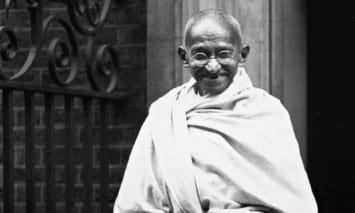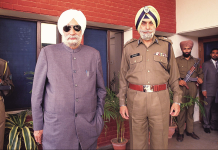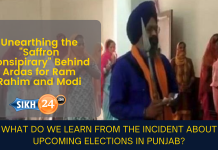

 The news in “The Sunday Telegraph” today, 9 Nov 2014 (p. 12), that the statue of Mr MK Gandhi is to be put up in London near that of Mr Nelson Mandela, is regrettable. The two could not differ more from each other in so many ways!
The news in “The Sunday Telegraph” today, 9 Nov 2014 (p. 12), that the statue of Mr MK Gandhi is to be put up in London near that of Mr Nelson Mandela, is regrettable. The two could not differ more from each other in so many ways!
Gandhi had stood for united India (his famous saying: “India will be cut on my dead body”!) but, despite being a barrister-at-law, he could not outwit Mr Jinnah who “captured” his Pakistan easily, without meeting with any resistance, condition or referendum! Gandhi “died” on the day the Islamic Pakistan came into being.
Mr Mandela successfully defied the Boers’ demand for a separate sovereign White Enclave in South Africa, and ensured the unity of the nation. We saw a few days ago how passionately you campaigned for keeping Scotland within the United Kingdom. Gandhi showed no such commitment or loyalty to India’s integrity and unity.
Nelson Mandela set up the African National Congress’ armed wing in 1961, when he lost hope that passive and non-violent resistance to the apartheid government would bear fruit. Mr. Gandhi was “wedded” to non violence to such a morbid extent that he had advised his followers to lie down in front of the advancing Japanese tanks instead of repulsing them by fighting.
Mandela sacrificed his happiness in marriage while Gandhi was a sexual delinquent who used to sleep with two maidens, one on either side, in bed for his sexual gratification.
“The Times” London, August 9, 2014, wrote, the Gandhi statue “would be an affront to women.” The founder of the Indo-British Heritage Trust has condemned a proposed statue of Mahatma Gandhi in Parliament Square as “unspeakable and absolutely unacceptable” because of the Indian independence leader’s “sexual exploitation of young women.”
Nelson Mandela’s permanent legacy to his people is a well-run united democratic South Africa. Not one person lost his life when the British left that country. On the other hand the departure of the British from Gandhi’s India was marked with history’s worst massacres and the final break up of India into three fragments and bloodshed- the worst being in the Punjab, Bengal and Kashmir.
The small but brave Sikh community, that had once defeated the Afghans to capture Khyber Pass and dominated North West India before the arrival of the British, was practically destroyed under Gandhi’s watch in 1947. The Sikhs looked up to him to (at least) stand up for Nankana Sahib, the birth place of Guru Nanak, and Lahore, the seat of the powerful Sikh Kingdom (until 1849).
While Mandela’s genius put the quarrelling Whites and the Blacks together, Gandhi’s lack of personality resulted in mounting inter Faith hostility, permanent suspicion and animosity between the Hindus and the Muslims, with the Kashmir dispute hanging overhead like Sword of Democles.
Mandela’s death meant the end of “Mandela” Dynasty. But in India after the death of Gandhi, the rulers fraudulently assumed the surname “Gandhi” in order to fool the people and stay on in power by hook or crook till ousted by Mr Modi’s party in May last.
Nelson Mandela’s South Africa has a future of peace and prosperity while Gandhi’s India is unstable within, and ready to implode in civil war any time resulting in great loss of life and property.
Gandhi’s cowardice at the Independence talks resulted in the betrayal of United India (Akhand Bharat). The biggest sufferers were the Punjab, Bengal and Kashmir, where great resentment still exists against Gandhi.
The present prime minister of India, Mr Narendra Modi, being a Gujarati like Gandhi, has championed his fellow Gujarati but the sight of the statue in London will be like salt in the wounds of the tens of millions of Indians who were forced to flee from the partitioned States of Punjab, Bengal and Kashmir and became refugees in their own country after Gandhi failed to provide resolute leadership.
It’s a great pity that Gandhi failed to be inspired by Sir Winston Churchill whose phrase “blood, toil, tears and sweat” became famous in a speech given to the House of Commons on 13 May 1940.
Gandhi’s India in 1947 was not in such mortal peril like the United Kingdom in 1940. With minimum of courage and sense of patriotism Gandhi could have turned the tide and averted the unconditional surrender of India to the indigenous Muslim minority!
It is easy to understand as to why the sight of Gandhi’s statue in London will cause revulsion to the Indians who belong to warrior classes, like the Marathas, the Rajputs, the Tamils, the Sikhs, the Jats, the Gurkhas, and so on, though he is still the idol of Mr. Modi and his fellow Gujaratis.
Gandhi’s statue in the land of heroes (the United Kingdom) will be embarrassing when eventually even in India the people learn the truth about the man and then remove, or smash, his statues like those of Marshal Stalin in Russia. Statues of cowardly leaders do not stand for long.
Gandhi’s inspiration to the armed forces was particularly negative. He regarded them “evil men of violence, trained to kill!” Though the Indian armed forces were moulded into discipline by the British genius to withstand Gandhi’s defeatist onslaught, the effect on civil administration has been horrendous. It is the “moribund” relic of Gandhian spirit, to be extremely corrupt, extremely inefficient, extremely sluggish and extremely unimaginative. The system manipulators, called the “ubiquitous baboons” are the cause of frustration and flight of most enterprising Indians who left for foreign shores. None will go back so long as Gandhian power vacuum prevails in India.
Finally, if the statue is put up it should be easy to remove later when the political wind changes in India.




